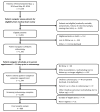A statewide program providing colorectal cancer screening to the uninsured of South Carolina
- PMID: 29415338
- PMCID: PMC5910186
- DOI: 10.1002/cncr.31250
A statewide program providing colorectal cancer screening to the uninsured of South Carolina
Abstract
Background: Cancer screening rates are lowest in those without insurance or a regular provider. Since 2008, the Colorectal Cancer Prevention Network (CCPN) has provided open access colonoscopy to uninsured residents of South Carolina through established, statewide partnerships and patient navigation. Herein, we describe the structure, implementation, and clinical outcomes of this program.
Methods: The CCPN provides access to colonoscopy screening at no cost to uninsured, asymptomatic patients aged 50-64 years (African Americans age 45-64 years are eligible) who live at or below 150% of the poverty line and seek medical care in free medical clinics, federally qualified health centers, or hospital-based indigent practices in South Carolina. Screening is performed by board-certified gastroenterologists. Descriptive statistics and regression analysis are used to describe the population screened, and to assess compliance rates and colonoscopy quality metrics.
Results: Out of >4000 patients referred to the program, 1854 were deemed eligible, 1144 attended an in-person navigation visit, and 1030 completed a colonoscopy; 909 were included in the final sample. Nearly 90% of participants exhibited good-to-excellent bowel preparation. An overall cecal intubation rate of 99% was measured. The polyp detection rate and adenoma detection rate were 63% and 36%, respectively, with male sex and urban residence positively associated with adenoma detection. Over 13% of participants had an advanced polyp, and 1% had a cancer diagnosis or surgical intervention.
Conclusion: The CCPN program is characterized by strong collaboration with clinicians statewide, low no-show rates, and high colonoscopy quality. Future work will assess the effectiveness of the navigation approach and will explore the mechanisms driving higher adenoma detection in urban participants. Cancer 2018;124:1912-20. © 2018 American Cancer Society.
Keywords: South Carolina; colonoscopy; colorectal neoplasms; early detection of cancer; patient navigation.
© 2018 American Cancer Society.
Conflict of interest statement
Figures
References
Publication types
MeSH terms
Grants and funding
LinkOut - more resources
Full Text Sources
Other Literature Sources
Medical



